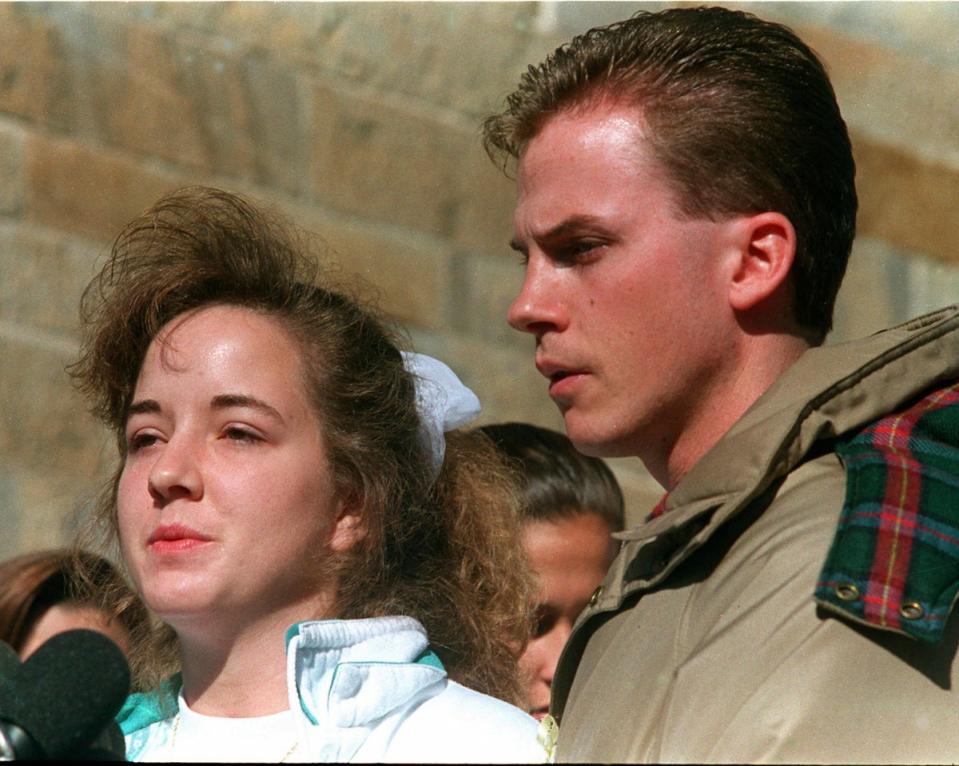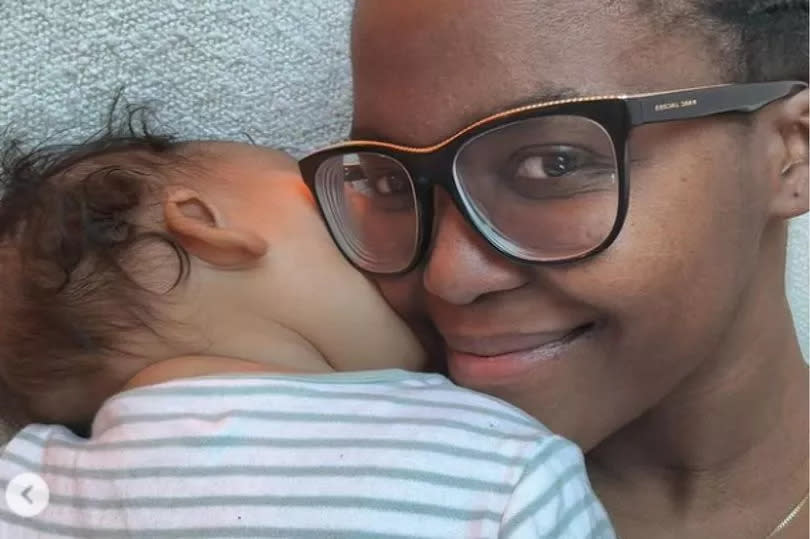Thirty years ago the story of a young white mother from South Carolina captured the nation’s attention when she claimed to have been carjacked by a Black man who forced her out of the vehicle and drove away with her two young sons in the car.
For nine days in October 1994, the community rallied behind Susan Smith, then 23, and her then-husband David, as they stood in front of TV cameras and tearfully pleaded for the safe return of their boys – Michael, 3, and Alexander, 14 months.
But the whole time, the bodies of the two little boys were at the bottom of a South Carolina lake, still strapped in their car seats inside their mother’s car.
The boys’ mother knew exactly where they were the whole time.

On November 3, 1994, Smith confessed that she had strapped her toddlers into their car seats, driven to a boat ramp, put her car in neutral and let it roll into the lake. She watched the car sink beneath the surface, with her children trapped inside.
And then she leaned into racist tropes and made up a story about an imaginary Black man and a fabricated carjacking.
The case became a national sensation, made international headlines and sparked numerous books, documentaries and movies.
Smith, now 53, is serving life in prison after a jury decided in 1995 not to sentence her to death. Under the law at the time, she was deemed eligible to seek parole after serving 30 years.
That time has come. In just a few days, the woman dubbed “Killer Mom” could be set free.
The case of the ‘Killer Mom’
In 1994, the small South Carolina town of Union was flooded with reporters, all chasing a terrifying story of a mother claiming she had been carjacked late at night on October 25 by a Black man with a gun who sped off with her two children still inside.
But investigators soon discovered that several details in Smith’s story did not add up. Carjackers usually just want a vehicle, so they wondered why this person would let Smith out but not her kids.
Smith initially told police that the carjacking happened at the Monarch Mills intersection while she was stopped at the traffic light, but investigators said it would only be red if another car was waiting to cross – yet Smith had said no other cars were around at the time.
In a revised statement, Smith only made one change – that the carjacking happened at the Carlisle intersection, not Monarch Hills.
Union County Sheriff Howard Wells confronted Smith about the conflicting details, informing her that undercover officers were working a drug investigation at that very intersection that night and yet they did not see the alleged carjacker, according to Sheriff Wells, who told her that he would have to tell the media about the lie because her accusation had caused tension in Union’s Black community.

Smith eventually confessed to the murders – revealing that she put her boys in their car seats and drove to John D. Long Lake, where she let her car roll down a boat ramp and into the water.
She told investigators that she had intended to kill herself along with her sons because she believed the boys were better off with her and God, rather than being left without a mother — but then had gotten out of the car.
A recreation by investigators showed it took six minutes for the Mazda to dip below the water surface, while cameras inside the vehicle showed water pouring in through the vents and steadily rising.
The boys’ bodies were found dangling upside-down in their car seats, one tiny hand pressed against a window.
‘I am not the monster society thinks I am’
Smith’s trial in July 1995 became a national sensation and a true crime touchstone despite it not being televised because Judge William Howard had been worried about the media circus surrounding the O.J. Simpson murder trial, which was going on at the same time.
Prosecutors said Smith’s motive for the murders stemmed from an affair she was having with a man named Tom Findlay, the son of a local, wealthy business owner.
A week before the murders, Findlay wrote a letter to Smith that would become central to her case. He told Smith that while he was interested in her romantically, he did not want children, according to a Birmingham News interview with Findlay in 2005.

Authorities at the time said that greed, ambition and Smith’s desire for a relationship with Findlay pushed her into getting rid of her children by murdering them.
Smith’s attorneys, however, claimed she was suffering a mental breakdown and intended to die alongside her children, but saved herself at the last moment, according to The New York Times.
The trial lasted less than a week, and, after less than two-and-a-half hours of deliberaton, the jury found Smith guilty on two counts of first-degree murder.
Judge Howard then sentenced her to 30 years to life in prison.
“We all felt like Susan was a really disturbed person,” juror Deborah Benvenuti told reporters following the verdict, according to the Washington Post. “And we all felt that giving her the death penalty wouldn’t serve justice.”
The boys’ father, David Smith, felt differently. He told reporters outside the courthouse at the time that he did not feel justice had been served.
The two were legally separated at the time of the murders, but David joined forces with Smith to find their sons. Everything changed when she confessed to killing their children.
“I’ll never forget what Susan has done and I’ll never forget Michael and Alex,” he said. “Me and my family of course are disappointed that the death penalty wasn’t the verdict.”
Meanwhile, over the years, Smith has said that she is misunderstood by society.
“I am not the monster society thinks I am,” she wrote in a letter to The State newspaper in 2015. “I am far from it.”
“Something went very wrong that night,” she added. “I was not myself. I was a good mother and I loved my boys. There was no motive as it was not even a planned event. I was not in my right mind.”
Drugs, sex and prison guards
From having sex with prison guards to violating policies and chatting up a number of obsessed suitors on the outside, Smith’s time behind bars has been mired in controversy.
Smith began her sentence at Camille Griffin Graham Correctional Institution in Columbia, South Carolina, where she was hit with two infractions for having sex with prison guards in 2000.
The incidents were discovered by an investigator who was looking into tabloid claims that Smith had been beaten.
Instead it was revealed that Smith, who was 28 at the time, had sex with 50-year-old prison guard Houston Cagle at least four times, according to UPI. Smith was disciplined and Cagle was fired.
Because of the power imbalance, “basically there is no such thing as consensual sex between staff and inmates,” said Corrections Department Director Doug Catoe, speaking about Cagle and Smith.
Then in September 2000, prison captain Alfred Rowe was arrested for having sex with Smith, according to ABC News. Rowe pleaded guilty and received five years probation.
Smith was then transferred to the Leath Correctional Institution in Greenwood, South Carolina.
Smith was disciplined at least five times between 2010 and 2017 for issues including self-mutilation and drug use, PEOPLE reported.
Could Susan Smith go free?
Smith’s parole hearing is scheduled for November 20 and will be done virtually, according to the state Department of Probation, Parole and Pardon Services.
Parole in South Carolina is only granted about 8 percent of the time and is less likely on an inmate’s first appearance before the board, in notorious cases, or when prosecutors and the families of victims are opposed, the Associated Press reported. Smith falls in all of those categories.
Tommy Pope, the lead prosecutor in Smith’s trial who is now the Republican Speaker Pro Tem of the South Carolina House, said he plans to tell the parole board that when jurors rejected the death penalty, they thought a life sentence meant the rest of her life and that they did not think she could be released after 30 years.
“Now she’s got sugar daddies that want to take care of her when she gets out. She’s continued to be focused on Susan,” Pope said.

Earlier this month, the South Carolina Department of Probation, Parole and Pardon Services confirmed to several news outlets that more than 127 letters have been submitted to their agency regarding Smith’s parole bid.
The letters are not publicly accessible, but a Smith family source told The New York Post that many of them are opposed to Smith’s potential release and are riddled with negative comments including one stating that Smith “belongs in that lake with her boys.”
‘I’m terrified she could possibly get out’
Smith filed for divorce from David in September 1994, weeks before she murdered their children. A judge granted their divorce in May 1995, a couple of months before her trial began.
David has since remarried and fathered two more children.
He recently said that he’s “terrified she could possibly get out” but said he will do “everything in my power” to keep Smith behind bars and revealed to Court TV what he would say if he came face-to-face with her.
“I would just tell her that you have no idea of how much damage you have done to so many people,” he said.
“I would tell her that in my capabilities I’m going to do everything in my power to make sure you stay behind bars.”
EMEA Tribune is not involved in this news article, it is taken from our partners and or from the News Agencies. Copyright and Credit go to the News Agencies, email news@emeatribune.com Follow our WhatsApp verified Channel




